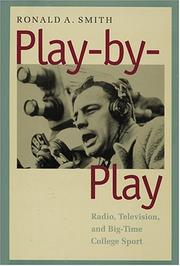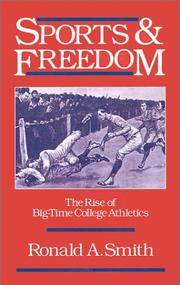| Listing 1 - 6 of 6 |
Sort by
|

ISBN: 0801866863 0801876923 9780801876929 9780801866869 Year: 2001 Publisher: Baltimore, Md. Johns Hopkins University Press
Abstract | Keywords | Export | Availability | Bookmark
 Loading...
Loading...Choose an application
- Reference Manager
- EndNote
- RefWorks (Direct export to RefWorks)
The phenomenal popularity of college athletics owes as much to media coverage of games as it does to drum-beating alumni and frantic undergraduates. Play-by-play broadcasts of big college games began in the 1920s via radio, a medium that left much to the listener's imagination and stoked interest in college football. After World War II, the rise of television brought with it network-NCAA deals that reeked of money and fostered bitter jealousies between have and have-not institutions. In Play-by-Play: Radio, Television, and Big-Time College Sport noted author and sports insider Ronald A. Smith examines the troubled relationship between higher education and the broadcasting industry, the effects of TV revenue on college athletics (notably football), and the odds of achieving meaningful reform. Beginning with the early days of radio, Smith describes the first bowl game broadcasts, the media image of Notre Dame and coach Knute Rockne, and the threat broadcasting seemed to pose to college football attendance. He explores the beginnings of television, the growth of networks, the NCAA decision to control football telecasts, the place of advertising, the role of TV announcers, and the threat of NCAA "Robin Hoods" and the College Football Association to NCAA television control. Taking readers behind the scenes, he explains the culture of the college athletic department and reveals the many ways in which broadcasting dollars make friends in the right places. Play-by-Play is an eye-opening look at the political infighting invariably produced by the deadly combination of university administrators, athletic czars, and huge revenue.
SPORTS & RECREATION --- History --- Mass media and sports --- College sports --- Sports and mass media --- Sports --- E-books --- College athletics --- Collegiate sports --- Intercollegiate athletics --- Intercollegiate sports --- Universities and colleges --- University athletics --- University sports --- Athletics --- Physical education and training --- School sports --- United States --- ABŞ --- ABSh --- Ameerika Ühendriigid --- America (Republic) --- Amerika Birlăshmish Shtatlary --- Amerika Birlăşmi Ştatları --- Amerika Birlăşmiş Ştatları --- Amerika ka Kelenyalen Jamanaw --- Amerika Qūrama Shtattary --- Amerika Qŭshma Shtatlari --- Amerika Qushma Shtattary --- Amerika (Republic) --- Amerikai Egyesült Államok --- Amerikanʹ Veĭtʹsėndi︠a︡vks Shtattnė --- Amerikări Pĕrleshu̇llĕ Shtatsem --- Amerikas Forenede Stater --- Amerikayi Miatsʻyal Nahangner --- Ameriketako Estatu Batuak --- Amirika Carékat --- AQSh --- Ar. ha-B. --- Arhab --- Artsot ha-Berit --- Artzois Ha'bris --- Bí-kok --- Ē.P.A. --- EE.UU. --- Egyesült Államok --- ĒPA --- Estados Unidos --- Estados Unidos da América do Norte --- Estados Unidos de América --- Estaos Xuníos --- Estaos Xuníos d'América --- Estatos Unitos --- Estatos Unitos d'America --- Estats Units d'Amèrica --- Ètats-Unis d'Amèrica --- États-Unis d'Amérique --- Fareyniḳṭe Shṭaṭn --- Feriene Steaten --- Feriene Steaten fan Amearika --- Forente stater --- FS --- Hēnomenai Politeiai Amerikēs --- Hēnōmenes Politeies tēs Amerikēs --- Hiwsisayin Amerikayi Miatsʻeal Tērutʻiwnkʻ --- Istadus Unidus --- Jungtinės Amerikos valstybės --- Mei guo --- Mei-kuo --- Meiguo --- Mî-koet --- Miatsʻyal Nahangner --- Miguk --- Na Stàitean Aonaichte --- NSA --- S.U.A. --- SAD --- Saharat ʻAmērikā --- SASht --- Severo-Amerikanskie Shtaty --- Severo-Amerikanskie Soedinennye Shtaty --- Si︠e︡vero-Amerikanskīe Soedinennye Shtaty --- Sjedinjene Američke Države --- Soedinennye Shtaty Ameriki --- Soedinennye Shtaty Severnoĭ Ameriki --- Soedinennye Shtaty Si︠e︡vernoĭ Ameriki --- Spojené obce severoamerické --- Spojené staty americké --- SShA --- Stadoù-Unanet Amerika --- Stáit Aontaithe Mheiriceá --- Stany Zjednoczone --- Stati Uniti --- Stati Uniti d'America --- Stâts Unîts --- Stâts Unîts di Americhe --- Steatyn Unnaneysit --- Steatyn Unnaneysit America --- SUA (Stati Uniti d'America) --- Sŭedineni amerikanski shtati --- Sŭedinenite shtati --- Tetã peteĩ reko Amérikagua --- U.S. --- U.S.A. --- United States of America --- Unol Daleithiau --- Unol Daleithiau America --- Unuiĝintaj Ŝtatoj de Ameriko --- US --- USA --- Usono --- Vaeinigte Staatn --- Vaeinigte Staatn vo Amerika --- Vereinigte Staaten --- Vereinigte Staaten von Amerika --- Verenigde State van Amerika --- Verenigde Staten --- VS --- VSA --- Wááshindoon Bikéyah Ałhidadiidzooígíí --- Wilāyāt al-Muttaḥidah --- Wilāyāt al-Muttaḥidah al-Amirīkīyah --- Wilāyāt al-Muttaḥidah al-Amrīkīyah --- Yhdysvallat --- Yunaeted Stet --- Yunaeted Stet blong Amerika --- ZDA --- Združene države Amerike --- Zʹi︠e︡dnani Derz︠h︡avy Ameryky --- Zjadnośone staty Ameriki --- Zluchanyi︠a︡ Shtaty Ameryki --- Zlucheni Derz︠h︡avy --- ZSA --- Η.Π.Α. --- Ηνωμένες Πολιτείες της Αμερικής --- Америка (Republic) --- Американь Вейтьсэндявкс Штаттнэ --- Америкӑри Пӗрлешӳллӗ Штатсем --- САЩ --- Съединените щати --- Злучаныя Штаты Амерыкі --- ولايات المتحدة --- ولايات المتّحدة الأمريكيّة --- ولايات المتحدة الامريكية --- 미국

ISBN: 0190281723 128052524X 0198022034 1423737326 1601297858 9781423737322 0195065824 9780195065824 019771644X Year: 2023 Publisher: New York ; Oxford University Press,
Abstract | Keywords | Export | Availability | Bookmark
 Loading...
Loading...Choose an application
- Reference Manager
- EndNote
- RefWorks (Direct export to RefWorks)
The development of inter-collegiate athletics in the USA is traced from the mid-19th to the early 20th centuries in this study, which examines in particular the influence of Harvard and Yale Universities.
College sports --- College athletics --- Collegiate sports --- Intercollegiate athletics --- Intercollegiate sports --- Universities and colleges --- University athletics --- University sports --- Athletics --- Physical education and training --- School sports --- History. --- Sports --- Yale University --- Harvard University --- Harvard College (1636-1780) --- Garvardskiĭ universitet --- Ha-fo ta hsüeh --- Hafo da xue --- President and Fellows of Harvard College --- Harvard Üniversitesi --- Universidad de Harvard --- Dānishgāh-i Hārvārd --- University in Cambridge (Cambridge, Mass.) --- Гарвардский университет --- 哈佛大學 --- 哈佛大学 --- Yale College (1718-1887) --- Universiṭat Yel --- 耶鲁大学 --- Ĭelʹskiĭ universitet --- Йельский университет --- Ĭelʹ (University) --- Йель (University)
Book
ISBN: 9780252098215 0252098218 9780252040016 9780252081491 0252040015 0252081498 Year: 2016 Publisher: Urbana
Abstract | Keywords | Export | Availability | Bookmark
 Loading...
Loading...Choose an application
- Reference Manager
- EndNote
- RefWorks (Direct export to RefWorks)
A rogue program, an iconic coach, and an unspeakable tragedy
College sports --- College athletics --- Collegiate sports --- Intercollegiate athletics --- Intercollegiate sports --- Universities and colleges --- University athletics --- University sports --- Athletics --- Physical education and training --- School sports --- Corrupt practices --- Sports --- Sandusky, Jerry. --- Paterno, Joe, --- Pennsylvania State University --- Pennsylvania State College --- Pennsylvania. --- Penn State --- PSU (Pennsylvania State University) --- PennState --- Administration. --- Football. --- Sports. --- Penn State University
Book
ISBN: 1282941623 9786612941627 0252090284 9780252090288 9780252035876 9780252077838 0252077830 0252035879 9781282941625 6612941626 Year: 2011 Publisher: Urbana, Chicago
Abstract | Keywords | Export | Availability | Bookmark
 Loading...
Loading...Choose an application
- Reference Manager
- EndNote
- RefWorks (Direct export to RefWorks)
College sports --- History. --- Moral and ethical aspects --- Law and legislation --- National Collegiate Athletic Association
Book
ISBN: 1477322876 Year: 2021 Publisher: Austin : University of Texas Press,
Abstract | Keywords | Export | Availability | Bookmark
 Loading...
Loading...Choose an application
- Reference Manager
- EndNote
- RefWorks (Direct export to RefWorks)
In this in-depth look at the heated debates over paying college athletes, Ronald A. Smith starts at the beginning: the first intercollegiate athletics competition—a crew regatta between Harvard and Yale—in 1852, when both teams received an all-expenses-paid vacation from a railroad magnate. This striking opening sets Smith on the path of a story filled with paradoxes and hypocrisies that plays out on the field, in meeting rooms, and in courtrooms—and that ultimately reveals that any insistence on amateurism is invalid, because these athletes have always been paid, one way or another. From that first contest to athletes’ attempts to unionize and California’s 2019 Fair Pay to Play Act, Smith shows that, throughout the decades, undercover payments, hiring professional coaches, and breaking the NCAA’s rules on athletic scholarships have always been part of the game. He explores how the regulation of male and female student-athletes has shifted; how class, race, and gender played a role in these transitions; and how the case for amateurism evolved from a moral argument to one concerned with financially and legally protecting college sports and the NCAA. Timely and thought-provoking, The Myth of the Amateur is essential reading for college sports fans and scholars.
College athletes --- College sports --- Professionalism in sports --- Scholarships, fellowships, etc --- History. --- Scholarships, fellowships, etc. --- amateurism, amateurism in sport, college sports, sports and culture, NCAA, college athletes, athletics, sports history, athletic scholarships, gender and sports.
Book
ISBN: 9781477322871 9781477322888 1477322884 1477322876 9781477322864 Year: 2021 Publisher: Austin : University of Texas Press,
Abstract | Keywords | Export | Availability | Bookmark
 Loading...
Loading...Choose an application
- Reference Manager
- EndNote
- RefWorks (Direct export to RefWorks)
In this in-depth look at the heated debates over paying college athletes, Ronald A. Smith starts at the beginning: the first intercollegiate athletics competition--a crew regatta between Harvard and Yale--in 1852, when both teams received an all-expenses-paid vacation from a railroad magnate. This striking opening sets Smith on the path of a story filled with paradoxes and hypocrisies that plays out on the field, in meeting rooms, and in courtrooms--and that ultimately reveals that any insistence on amateurism is invalid, because these athletes have always been paid, one way or another. From that first contest to athletes' attempts to unionize and California's 2019 Fair Pay to Play Act, Smith shows that, throughout the decades, undercover payments, hiring professional coaches, and breaking the NCAA's rules on athletic scholarships have always been part of the game. He explores how the regulation of male and female student-athletes has shifted; how class, race, and gender played a role in these transitions; and how the case for amateurism evolved from a moral argument to one concerned with financially and legally protecting college sports and the NCAA. Timely and thought-provoking, The Myth of the Amateur is essential reading for college sports fans and scholars.
College athletes --- College sports --- Professionalism in sports --- Scholarships, fellowships, etc --- History. --- Scholarships, fellowships, etc. --- amateurism, amateurism in sport, college sports, sports and culture, NCAA, college athletes, athletics, sports history, athletic scholarships, gender and sports. --- United States
| Listing 1 - 6 of 6 |
Sort by
|

 Search
Search Feedback
Feedback About UniCat
About UniCat  Help
Help News
News